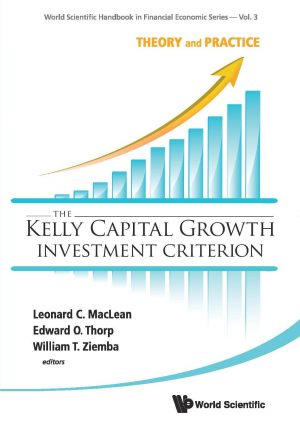The Kelly Capital Growth Investment Criterion: Theory and Practice
About the Book
This volume provides the definitive treatment of fortune’s formula or the Kelly capital growth criterion as it is often called. The strategy is to maximize long run wealth of the investor by maximizing the period by period expected utility of wealth with a logarithmic utility function. Mathematical theorems show that only the log utility function maximizes asymptotic long run wealth and minimizes the expected time to arbitrary large goals. In general, the strategy is risky in the short term but as the number of bets increase, the Kelly bettor’s wealth tends to be much larger than those with essentially different strategies. So most of the time, the Kelly bettor will have much more wealth than these other bettors but the Kelly strategy can lead to considerable losses a small percent of the time. There are ways to reduce this risk at the cost of lower expected final wealth using fractional Kelly strategies that blend the Kelly suggested wager with cash. The various classic reprinted papers and the new ones written specifically for this volume cover various aspects of the theory and practice of dynamic investing. Good and bad properties are discussed, as are fixed-mix and volatility induced growth strategies. The relationships with utility theory and the use of these ideas by great investors are featured.
- Author: Leonard C. MacLean (Editor), Edward O. Thorp (Editor), William T. Ziemba (Editor)
- Publisher: World Scientific (Distributed exclusively by Dev Publishers & Distributors)
- Edition: First
- Year: 2018
- Dimension: 16 x 25 cm
- No. of Pages: 884
- Weight: 1120 gm
- ISBN: 9789814383134
- Binding: Softcover
- Territory: South Asia
- Price: ₹ 1995
About the Author
Leonard C MacLean is the Herbert S Lamb Chair in Business at the School of Business Administration, Dalhousie University, Halifax, Nova Scotia, Canada. His research interests include stochastic optimization models in finance, and models for repairable systems in aviation, funded by grants from the Natural Sciences and Engineering Research Council of Canada.
Edward O Thorp is widely known as the author of the 1962 Beat the Dealer, which was the first book to prove mathematically that blackjack could be beaten by card counting, and the 1967 Beat the Market, which showed how warrant option markets could be priced and beaten. He is regarded as one of the best hedge fund managers in the world. He is also regarded as the co-inventor of the first wearable computer along with Claude Shannon. Thorp received his PhD from the University of California, Los Angeles in 1958 and worked at MIT from 1959 to 1961. He was a professor of mathematics from 1965 to 1977 and a professor of mathematics and finance from 1977 to 1982 at the University of California, Irvine.
William T Ziemba is the Alumni Professor (Emeritus) of Financial Modeling and Stochastic Optimization in the Sauder School of Business, University of British Columbia, Canada where he taught from 1968 to 2004. He obtained his PhD from the University of California, Berkeley in 1969. He now teaches as a Visiting Professor at world-reknowned institutions including Cambridge, Oxford, London School of Economics, Reading ICMA Centre, and Warwick in the UK; Stanford, UCLA, Berkeley, Chicago and MIT in the US; Bergamo and Venice in Italy; Toulouse and EDHEC in France; Tsukuba in Japan; the National University of Singapore and the National Technological University in Singapore. Leading financial institutions, which he has been consultant to, include the Frank Russell Company, Morgan Stanley, Buchanan Partners, Gordon Capital, Matcap Capital, and Private International Wealth Management. His research is in asset-liability management, portfolio theory and practice, security market imperfections, Japanese and Asian financial markets, sports and lottery investments, and applied stochastic programming.


